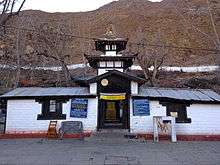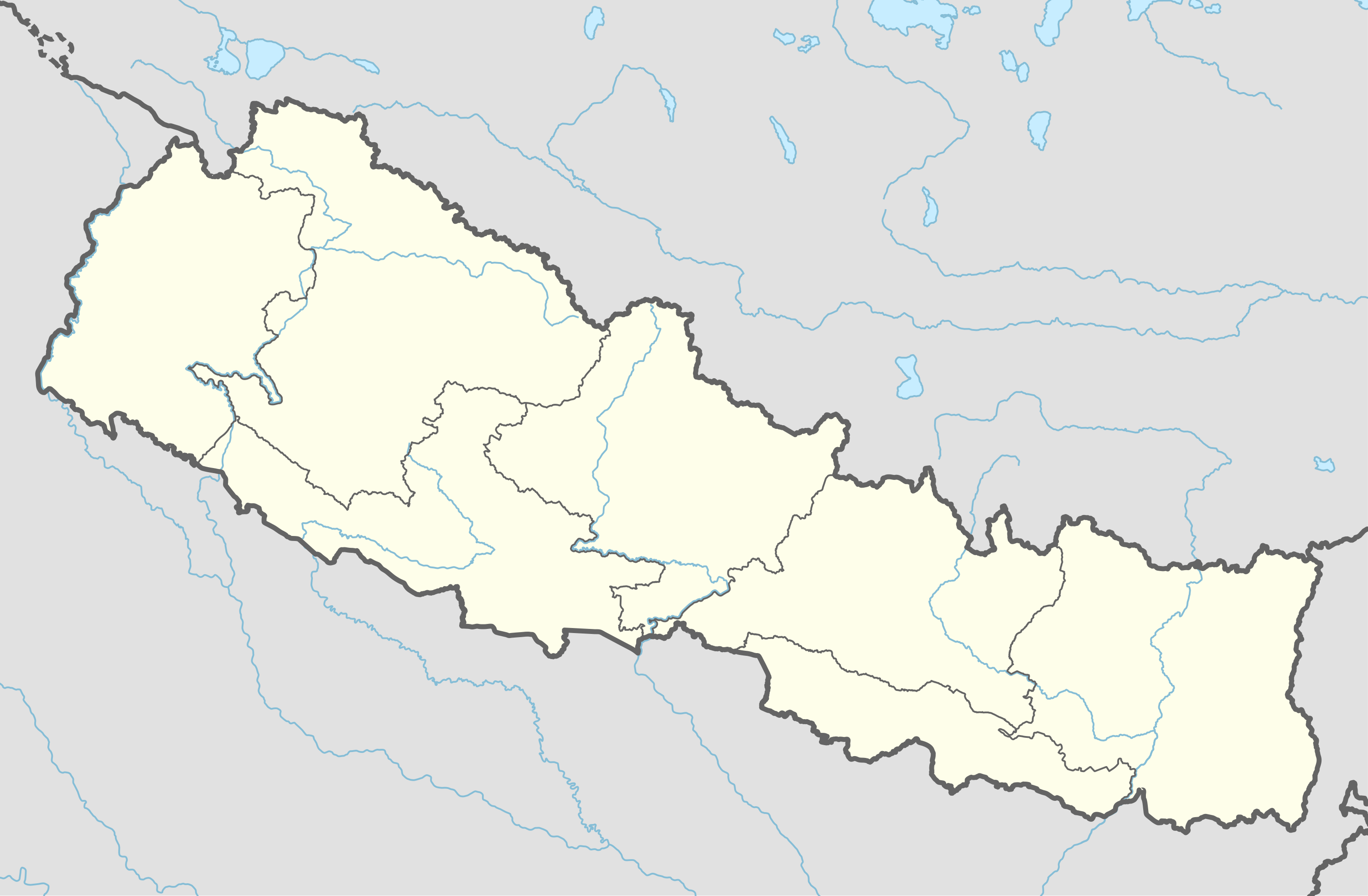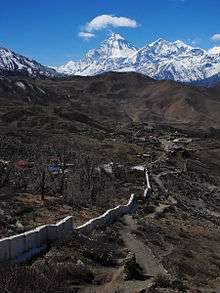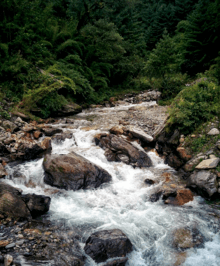Muktinath
| Muktinath Temple | |
|---|---|
 Muktinath Temple | |
 Location in Nepal | |
| Geography | |
| Coordinates | 28°49′0″N 83°52′15″E / 28.81667°N 83.87083°ECoordinates: 28°49′0″N 83°52′15″E / 28.81667°N 83.87083°E |
| Country | Nepal |
| District | Mustang District |
| Location | Muktinath (Dhawalagiri) |
| Culture | |
| Sanctum | Muktinath, Sri Devi Thayaar, Sri Murthy |
| Temple tank | Gandaki River or Chakra Theertham |
| Tower | Kanaka Vimanam |
| Architecture | |
| Architecture | Pagoda |

Muktinath is a sacred place for both Hindus and Buddhists located in Muktinath Valley at an altitude of 3,710 meters at the foot of the Thorong La mountain pass (part of the Himalayas) in Mustang, Nepal. The site is close to the village of Ranipauwa, which is sometimes mistakenly called Muktinath.
Within Hinduism, it is called Mukti Kshetra, which literally means the "place of liberation or moksh". This temple is considered to be 106th among the available 108 Divya Desam (premium temples) considered sacred by the Sri Vaishnava sect. The ancient name of this place in Sri Vaishnava literature, before Buddhist origin, is Thiru Saligramam. This houses the Saligram shila, considered to be the naturally available form of Sriman Narayan[1] – the Hindu Godhead. It is also one of the 108 Siddhpeeth & is named Mahadevi[Devibhagwat 7.14]. The Buddhists call it Chumig Gyatsa, which in Tibetan means "Hundred Waters". Although the temple has a Vaishnav origin, it is also revered in Buddhism because guru padmasambhava meditated there for some time.[2] For Tibetan Buddhists, Muktinath is a very important place of dakinis, goddesses known as Sky Dancers, and one of the 24 Tantric places. They understand the murti to be a manifestation of Avalokiteśvara, who embodies the compassion of all Buddhas.[3]
The central temple
The central shrine of Sri Muktinath is considered by Hindu Vaishnavas to be one of the eight most-sacred shrines, known as Svayam Vyakta Ksetras; the other seven being Srirangam, Srimushnam, Tirupati, Naimisharanya, Thotadri, Pushkar and Badrinath. The temple is very small. Muktinath is one of the most ancient Hindu temples of God Vishnu. The murti is of gold and is tall enough to compare with a man. The prakaram (outer courtyard) has 108 bull faces through which water is poured. The sacred water that flows in 108 pipes around the temple complex denotes all the sacred Pushkarini waters (Temple Tanks) from all the 108 Sri Vaishnava Divya Desams, where the devotees take their sacred bath even in freezing temperatures. The worship is conducted by Buddhists, with a Buddhist monk present. A local nun manages the pujas (prayer rituals) in the temple. Pilgrims who go there are expected to offer a prasad (religious offering of food) to the deity.
As a Shakti Peetha
The Muktinath Temple is considered to be a Shakti Peetha for a yatra. It is one of the 108 Siddhpeeth & is named Mahadevi[Devibhagwat 7.14]. Shakti Peethas are sacred abodes of Shakti (primordial cosmic energy), formed by the falling of body parts of the corpse of Sati Devi, when Lord Shiva carried it and wandered. There are 51 Shakti Peethas revered by Shaktism, connecting them to the 51 alphabets in Sanskrit. Each Shakti Peetha has a Shakti shrine and a Bhairav shrine in its temple. The Shakti of Muktinath is addressed as "Gandaki Chandi", and the Bhairava as "Chakrapani". Sati Devi's temple on the forehead is believed to have fallen here.[4][5][6]
Legend
The Tibetan Buddhist tradition states that Guru Rinpoche, also known as Padmasambhava, the founder of Tibetan Buddhism, had meditated at Muktinath on his way to Tibet. This temple is praised by many saints of Hindu tradition. The scripts narrating the importance of this temple are available in Vishnu Purana with the Gandaki Mahathmya.
The waterway downstream from Muktinath along Kali Gandaki is the source of all Silas or Shaligrams that are required to establish a temple of Vishnu. It is considered to be one of the holiest places of pilgrimage for Hindus and Buddhists. It has 108 water springs, a number which carries great significance in Hindu philosophy. As an example of the mystery surrounding the number 108, in Hindu astrology, there are mentions of 12 zodiacs (or Rashi) and 9 planets (or Graha), giving a total of 108 combinations. There are also 27 Lunar mansions (or Nakshatras) which are divided into 4 quarters (or Padas) each giving a combination of 108 Padas in total.
Sri Murthy Mahatmyam
This is probably the only place on earth where one can find all five elements (fire, water, sky, earth and air) from which all material things in the universe are made, according to Hindu and Buddhist traditions. They are all found at the same place together in their own and distinct form. This place is near Jwala Devi temple.
The entire river Gandaki bed has Shaligram stones which are used to worship Lord Vishnu.
According to Sri Vaishnava philosophy (a sub-sect of Hindu philosophy), it is considered to be one of the most-sacred places of worship of Lord Vishnu, praised by Thirumangai Alwar in the compilation of Nalayira Divya Prabandha 10 Pasurams in Mudal pathu Iyndham thirumozhi
It is said that one has to be gifted to get the 'darśan' (divine presence), as the deity in the temple Lord Sri Vishnu murthi and Goddess SriDevi and Bhoodevi believed to give Jeevan Mukthi hence He is called MUkTHINATH
Sri Vaishnavic reference
Sri Vaishnava tradition is a sub-sect of Hinduism, predominant in present-day Tamil Nadu in southern India. Many great devotees have contributed to it, the most prominent of them being the Alvars. Thirumangai Alvar could not reach Muktinath, but had sung 10 pashurams from the nearest place, in praise of Lord Sri Murthy. Periyalvar had sung in praise of Sri Murthi as "Salagramamudaiya Nambi". The pontiff of Srivilliputtur (the most venerated Srivaishnava pilgrim centre in Tamil Nadu), Sri Manavala Mamunigal Mutt H.H 23rd peetam Sri Sri Sri Satakopa Ramanuja Jeeyar Swamiji installed the idols of Andal (Sri Gotha Devi), Ramanuja, and Manavala Mamunigal in this sacred place of predominantly Sri Vaishnava origin during the yagna performed between 3 and 6 August 2009. This is considered by the devotees to be one of the milestones in the history of Muktinath. A large crowd of Sri Vaishnava devotees visit this most sacred Sri Vaishnavaitic shrine, where the Lord resides in the form of Sri Paramapatha Nathan with His divine consorts of Sri, Bhoomi, Neela and Gotha Devis.
Travel access

Access is difficult because of harsh weather conditions in Mustang. The most suitable time to visit is from March to June. There are flights from Kathmandu to Pokhara and then to Jomsom Airport. From there, one can either trek all the way or take a jeep to Muktinath, a journey which passes many archeological sites and temples. Tourists are also known to charter a helicopter for a 45-minute flight, though this carries a risk of acute mountain sickness (AMS) and is only recommended for brief visits.
Gallery
- Entrance to the temple area



 Muktinath Temple
Muktinath Temple- Pilgrim showering under the 108 holy Taps with friends filming
- Close-up of one the 108 holy Taps
- Bells, burning incense and a smoking candle
 Inside Muktinath
Inside Muktinath Holy Water Sprouts
Holy Water Sprouts
See also
References
- ↑ http://www.ramanuja.org/sv/bhakti/archives/sep97/0045.html
- ↑ Mittal, Sushil (2004). The Hindu World. New York: Routledge. p. 499. ISBN 0-203-67414-6.
- ↑ Zurick, David (2006). Illustrated Atlas of the Himalayas. Lexington: University Press of Kentucky. p. 153.
- ↑ (Translator), F. Max Muller (June 1, 2004). The Upanishads, Vol I. Kessinger Publishing, LLC. ISBN 1419186418.
- ↑ (Translator), F. Max Muller (July 26, 2004). The Upanishads Part II: The Sacred Books of the East Part Fifteen. Kessinger Publishing, LLC. ISBN 1417930160.
- ↑ "Kottiyoor Devaswam Temple Administration Portal". Kottiyoor Devaswam. Retrieved 20 July 2013.
External links
| Wikimedia Commons has media related to Muktinath. |

